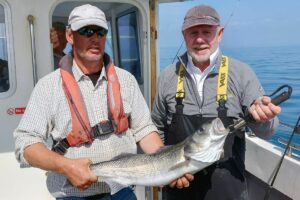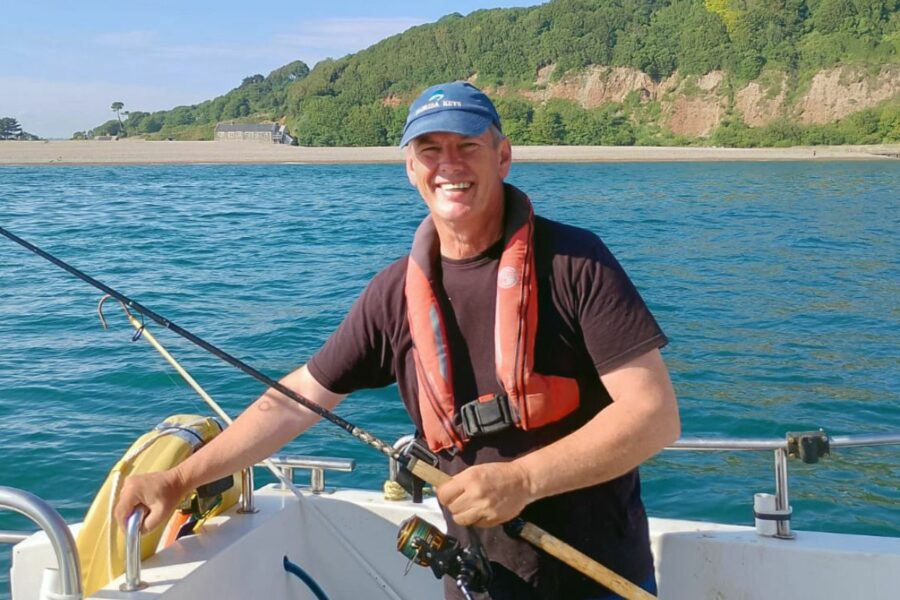Share a day in the life of an Axmouth line fisherman who combines charter and commercial fishing

Axmouth-based John Wallington (left) with one of his angling customers and a 10lb 3oz line-caught bass. John’s innovative business model combines charter angling with commercial fishing. “This is my sole occupation – I couldn’t survive without both sides of the business.”
Prior to fishing, all my life had been in the foodservice industry – I’m trained to look after people,” Axmouth-based fisherman John Wallington told Fishing News. “That’s where this model doesn’t suit some fishermen – they’re not used to dealing with the general public. Many of them tell me they couldn’t do it.”
Originally from the Wirral in Merseyside, it was childhood holidays to Cornwall that inspired both John’s early and current careers. “I used to holiday down on the Fowey from the age of six. That’s when I first got into fishing. That’s also the reason I became a chef – because I had been fishing from such a young age. I went to catering college aged 16, and spent 25 years in the foodservice industry.”
On moving to Seaton in Devon in 1994, John opened his own restaurant. One of his diners proved pivotal in his transition from restauranteur to commercial fisherman.
“One of my customers invited me out – and I thought, this is real fishing. So I got my own boat – a little Isle of Wight Plastic 15, which I had for a year or two. Then I got a Shetland 535.”
After selling his restaurant in 2000, John started working towards making a living from the sea, and by 2003, he had bought his first commercial boat.
On his vessel Outcast III E 584, John operates an innovative business model, combining charter and commercial fishing. “The MCA was bringing in legislation regarding crews having to be qualified. In our little port, getting crew is nearly impossible – we haven’t got a big pool of people like Brixham, for example.
“I thought it was an easier way to get all my tickets up to Yacht Master Commercial endorsement for taking out paying passengers – so that’s what I did. My customers get the best of each species they land. I keep the rest – and sell it.”
At this time of the year John fishes out of Axmouth, targeting bass, black bream and pollack. From November through to the end of January, he works out of Portland, Dorset, focusing on bass.
When in Axmouth, the start of John’s day very much depends on the tide. “Because I’m tidal, I can start anywhere from 6am to midday. I only operate in daylight hours due to the river mouth. My first job is to pick up the fuel and ice and drop that on the boat. I then go and meet the customers who are coming out with me.
“I start by giving them a safety briefing. I nominate a designated radio operator – whether they want to do it or not – just in case anything happens to me. I’ll explain about when to put down their gear, when to bring the gear up, how to stow the gear – and what the most dangerous thing on the boat is: the lead weights. I have pots on the rail where they put their weights. I don’t let them land a fish unless they’ve got hold of the weight. If a weight catches me on the temple, then that’s me out – and then it’s a Mayday call.”
John’s next task is to navigate Axmouth’s notorious river mouth. “We have a very narrow, very shallow pebble bar. It’s one of the most dangerous commercial ports in the country. You’re glad when you’re out, and you’re even more glad when you’ve got back in again.”

John leading a safety talk onboard his 7.6m Cougar cat Outcast III. “The boat does anywhere between 16 and 18 knots. I get about a bit, and probably on an average day I’ll use four tubs of fuel, which is 100 litres. She only does three litres to the mile – but if I’ve got two customers on, then my fuel is paid for. Three customers, and the boat’s paid for.”
Once safely out, John heads to nearby grounds if targeting black bream, or to wrecks further afield for bass and pollack.
“It’s usually between seven to 10 miles to the first wreck. If the fish aren’t there, then I’ll do anything up to six wrecks in a day. Usually, trips are eight hours plus – as I can’t get back in because of the tides. Once I’m out, that’s it – I’m out.”
Once the fishing gets underway, John is on hand to help his customers. “I look after them, and the more they catch, the more I make. A nice day for me is if we’ve got five customers onboard. They take a fish each – and if I’ve got 20kg of bass left, then I’m happy.”
With the day’s catch stowed onboard, John begins the journey back in, with thoughts focused once more on navigating the entrance to Axmouth harbour. “I always check my fuel just off the river mouth before we come in. It’s then a case of action stations – and we hang on.
“Once we’re back in, I’ll give the customers their fish. My own fish goes into the ice house at the river. It’s sold locally to Lyme Bay Seafood Company – with any excess going down to the market at Brixham. We have a van that picks it up three times a week.”
With his customers off celebrating their catch in the local pub, John heads home.
“It’s normally a 10-hour day by the time I’ve filled out the CatchApp, dropped the fish off, got home, made a cup of tea and checked the weather for the next day.
“How tired I am depends on how many days I’ve worked before – I’ll try not to fall asleep in my dinner!”
This story was taken from the latest issue of Fishing News. For more up-to-date and in-depth reports on the UK and Irish commercial fishing sector, subscribe to Fishing News here or buy the latest single issue for just £3.50 here.
Sign up to Fishing News’ FREE e-newsletter here.








